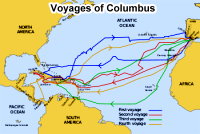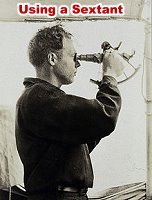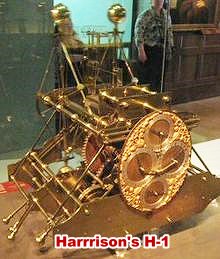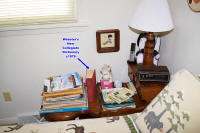|
<Previous
Next>
 Knowing that I am an avid consumer of literature
pertaining to time and astronomy, Melanie picked up a book at the library for me
entitled,
Longitude: The True Story of a Lone Genius Who Solved the Greatest
Scientific Problem of His Time, by
Dava
Sobel. When Christopher Columbus discovered America, his intended target was,
if you recall, the Indies. His original charter was to find a direct westerly pathway
from the Atlantic coast of Europe to the immensely profitable trade production region
of the Indies as an alternative to to sailing around the treacherous
Cape of Good Hope
at the southern tip of Africa. How could such an experienced navigator have missed
his mark by so far, you might reasonably ask? Didn't Columbus know how to use a
sextant, or at
least have a navigator who could? Knowing that I am an avid consumer of literature
pertaining to time and astronomy, Melanie picked up a book at the library for me
entitled,
Longitude: The True Story of a Lone Genius Who Solved the Greatest
Scientific Problem of His Time, by
Dava
Sobel. When Christopher Columbus discovered America, his intended target was,
if you recall, the Indies. His original charter was to find a direct westerly pathway
from the Atlantic coast of Europe to the immensely profitable trade production region
of the Indies as an alternative to to sailing around the treacherous
Cape of Good Hope
at the southern tip of Africa. How could such an experienced navigator have missed
his mark by so far, you might reasonably ask? Didn't Columbus know how to use a
sextant, or at
least have a navigator who could?
 The answer to the second question is, "no."
The answer to the first question is complicated. Recall your elementary school poem
titled In 1942, which began "In fourteen hundred ninety-two, Columbus sailed
the ocean blue." John Hadley's and Thomas Godfrey's sextant - originally called
an octant - was not invented and refined until the middle of the 18th century. The answer to the second question is, "no."
The answer to the first question is complicated. Recall your elementary school poem
titled In 1942, which began "In fourteen hundred ninety-two, Columbus sailed
the ocean blue." John Hadley's and Thomas Godfrey's sextant - originally called
an octant - was not invented and refined until the middle of the 18th century.
The answer to the first question is that prior to the advent of the sextant and
accurate sea-going clocks, determining latitude was easy, but determining longitude
was mostly guesswork and dead reckoning. Nobody in Columbus' day had a reliable means for
computing longitude after more than a day or so at sea and out of sight of a known
land mass.
 As was (and still
is) the case with many major scientific advances, the road to success was riddled
with many technical, personal, and political obstacles. Prior to the last century,
organized religions often were the most severe inhibitors of success - recall the
Inquisition of Galileo for proclaiming a
heliocentric universe. The pathway to discovering a means for
determining longitude was strewn with all those forms of treachery. As was (and still
is) the case with many major scientific advances, the road to success was riddled
with many technical, personal, and political obstacles. Prior to the last century,
organized religions often were the most severe inhibitors of success - recall the
Inquisition of Galileo for proclaiming a
heliocentric universe. The pathway to discovering a means for
determining longitude was strewn with all those forms of treachery.
Because so many ships - both commercial and military - were succumbing to perils
of misadventure on the high seas, both England and France convened panels of mathematicians,
sailors, astronomers, politicians, and clergy (what could go wrong?) to incentivize,
judge, and reward efforts to solve "The Longitude Problem." England established
its Board
of Longitude in 1714, and France created its
Bureau
des Longitudes in 1795 (a bit late to the game). The grand reward for producing
a reliable method for determining longitude within half a degree, known as the
Longitude
Prize, was £20,000 - or about
£1,991,632 in 2024 money ($2,529,401 US).
Two competing, though in reality somewhat interdependent, methods were pitted
against each other in the race for a solution - astronomical and chronological.
The astronomical method which employed the sextant requires very accurate ephemerides
of sun, moon, planet, and star positions. The chronological method requires a timekeeping
apparatus that neither gains nor loses more than a few seconds per day while aboard
a seafaring vessel being subject to wide variations in temperature, humidity, barometric
pressure, a severe three-dimensional motion.
 Astronomers and mathematicians worked tirelessly
all over the known world observing and recording positions of heavenly objects -
the moving planets ("planet" meaning "wanderer"),
moon, sun, and the fixed stars.
Johannes Kepler's derived laws of planetary motion and
Isaac Newton's recent formulation of the laws of gravity play
key roles in the ability to accumulate and publish yearly massive volumes of critical
navigational data. Even so, very accurate reckoning of time was required to gain
high accuracy in longitude determination. In fact, it could take a single navigator
up to four hours to compute the longitude based on sextant readings. Astronomers and mathematicians worked tirelessly
all over the known world observing and recording positions of heavenly objects -
the moving planets ("planet" meaning "wanderer"),
moon, sun, and the fixed stars.
Johannes Kepler's derived laws of planetary motion and
Isaac Newton's recent formulation of the laws of gravity play
key roles in the ability to accumulate and publish yearly massive volumes of critical
navigational data. Even so, very accurate reckoning of time was required to gain
high accuracy in longitude determination. In fact, it could take a single navigator
up to four hours to compute the longitude based on sextant readings.
The chronological longitude measuring method required precisely synchronized
clocks based at the reference site at England's
Royal Observatory - located on the declared prime meridian at
Greenwich - and the remote location on a ship. Accordingly, the navigator would
note the local time that a particular astronomical measurement was made (occultation
of a star or Jovian moon by a planet or Earth's moon, a particular star observed
at the zenith, etc.) and then compare it with the time the event would have occurred
back "home" in Greenwich. Regardless of latitude, the earth rotates at a rate of
once every 24 hours, so every hour of time difference equals 360/24 = 15 degrees
of longitude, and every minute of time equals 1/4 of a degree of longitude.
 Almost without a serious competitor, self-taught
clockmaker John
Harrison built four versions of his "sea clocks" over a period of forty years.
He devised ingenious methods of "frictionless" bearings made of naturally oily woods,
bimetal temperature-compensating pendulum components, winding mechanisms that did
not halt clockworks movement during the winding process, and special construction
of gears to eliminate cog mesh gaps, etc. His first model, which called "H-1," was
a few feet of dimension on each side and weighted a few hundred pounds. By the time
the H-4 was built - the model that finally won Harrison most of the Longitude Prize
- Harrison was in his late sixties. It took the intervention of avid amateur astronomer
King George III (the very same His Highness to whom the
Declaration of Independence was delivered by the
Continental
Congress) to finally get Harrison his greatly deserved and hard-fought-for money. Almost without a serious competitor, self-taught
clockmaker John
Harrison built four versions of his "sea clocks" over a period of forty years.
He devised ingenious methods of "frictionless" bearings made of naturally oily woods,
bimetal temperature-compensating pendulum components, winding mechanisms that did
not halt clockworks movement during the winding process, and special construction
of gears to eliminate cog mesh gaps, etc. His first model, which called "H-1," was
a few feet of dimension on each side and weighted a few hundred pounds. By the time
the H-4 was built - the model that finally won Harrison most of the Longitude Prize
- Harrison was in his late sixties. It took the intervention of avid amateur astronomer
King George III (the very same His Highness to whom the
Declaration of Independence was delivered by the
Continental
Congress) to finally get Harrison his greatly deserved and hard-fought-for money.
Longitude: The True Story of a Lone Genius Who Solved the Greatest Scientific
Problem of His Time is a very worthwhile read for anyone interested in the
history of
clock making and timekeeping. Author Sobel tells an interesting
tale of the catastrophic shipwrecks resulting from literally being lost at sea,
thereby predicating the urgent need for precise longitude measurement, and of the
sordid actions of bureaucrats and jealous men who sat in judgment and regulation
of those who produce useful outcomes. It shows what determination and stick-to-itiveness
can yield. Not every worthy endeavor results in eventual victory as did Harrison
with his sea clocks, so it is nice to know that occasionally the good guy wins.
Surprisingly, there are no images published in the book. Here are detailed photographs
of the H-1,
H-2,
H-3, and
H-4 sea clocks.
 On a side note, a thought occurred to me
the other night while reading Longitude. I do most of my reading - both
books and magazines - in bed at night, usually at least an hour's worth. Since I
keep neither a cellphone nor other Internet-connected device nearby, I have a 1976
vintage Webster's New Collegiate Dictionary bedside that is used for looking
up word definitions. I wonder how many people can quickly look up a word in a dictionary
these days? It might seem like a self-serving question, but does a generation that
has grown up with Internet look-ups get practice thinking about the alphabetical
order of letters in a word - not just the first letter but the second and third,
etc.? Does that same generation that has been able to click a button to have the
word pronounced audibly know how to interpret the dictionary symbols for long and
short vowels, syllable accents, hard or soft consonants? Often I end up scanning
over the page noting definitions of other familiar and unfamiliar words. I suppose
just like knowing you have to actually wait for the dial on a rotary telephone to
return to a stop before dialing the next number (see hilarious
video),
they will never need to use a physical dictionary, so why bother learning? Here
is one really big benefit to using my Webster's dictionary: When I do find the word
I am looking for, no advertisement or notification of cookie policy ever pops up
in front of the page, needing to be clicked to actually read the definition. On a side note, a thought occurred to me
the other night while reading Longitude. I do most of my reading - both
books and magazines - in bed at night, usually at least an hour's worth. Since I
keep neither a cellphone nor other Internet-connected device nearby, I have a 1976
vintage Webster's New Collegiate Dictionary bedside that is used for looking
up word definitions. I wonder how many people can quickly look up a word in a dictionary
these days? It might seem like a self-serving question, but does a generation that
has grown up with Internet look-ups get practice thinking about the alphabetical
order of letters in a word - not just the first letter but the second and third,
etc.? Does that same generation that has been able to click a button to have the
word pronounced audibly know how to interpret the dictionary symbols for long and
short vowels, syllable accents, hard or soft consonants? Often I end up scanning
over the page noting definitions of other familiar and unfamiliar words. I suppose
just like knowing you have to actually wait for the dial on a rotary telephone to
return to a stop before dialing the next number (see hilarious
video),
they will never need to use a physical dictionary, so why bother learning? Here
is one really big benefit to using my Webster's dictionary: When I do find the word
I am looking for, no advertisement or notification of cookie policy ever pops up
in front of the page, needing to be clicked to actually read the definition.
Posted April 10. 2024
(updated from original post on 3/7/2017)
|


























 "
"





